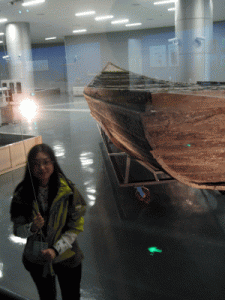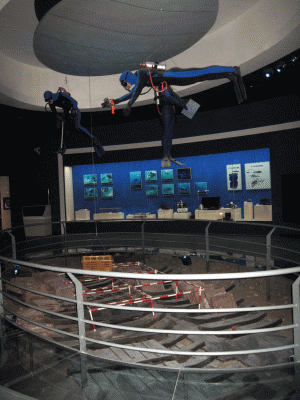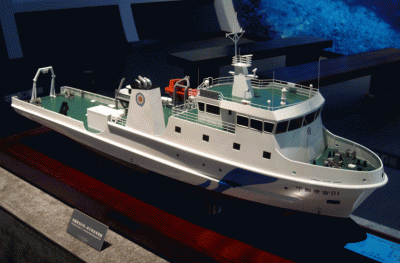November 26, 2014, by Jon Henderson
Underwater Archaeology in China
Last month I was in China as I was invited to present a paper at the First Ningbo Forum of Underwater Archaeology held to mark the opening of a new National Underwater Cultural Heritage Conservation Base in Ningbo and the official opening of the China Port Museum.

My guide and expert translator for the conference was one of my past students, Yiheng Zhou, a former undergraduate of the University of Nottingham who now works for the Ningbo Municipal Institute of Cultural Relics and Archaeology.
As luck would have it Nottingham has a campus in Ningbo and I had a chance to visit and meet some staff. It’s a surreal experience visiting the Ningbo campus as it feels exactly like a piece of Nottingham which has been directly transported to China. A feeling which is in no small way enhanced by the fact the main building is a replica of the Nottingham Trent Building replete with clock tower and hourly chimes (the sound is actually a recording of the bell from Trent!). More than that, the feel of the lush green campus is similar, there is the same signage written in the same font as in the UK, the same standard University furniture in staff offices while the latte served in the coffee bar is indistinguishable from that back home. The only give away is that this seemingly familiar landscape is surrounded on all sides by the spectacular sight of the skyscrapers of Ningbo City in various states of completion.
The Ningbo underwater archaeology conference was fascinating as it was a chance to hear about the various projects and initiatives taking place in China at the moment. China has been active in underwater archaeology since the 1970’s but since 2012, when the national Chinese Centre for Underwater Cultural Heritage was founded, there has been significant investment and expansion in China’s ability to carry out large scale underwater archaeology projects. This was evident not simply from the range of shipwreck projects presented at the conference but also from the fact that Chinese underwater archaeology encompasses not only the examination of inland lake sites and riverine systems but is now international with Chinese led projects taking place in Kenya.
Significantly UNESCO’s Ulrike Guerin gave the conference keynote presentation outlining the advantages to China in signing the UNESCO Convention on the Protection of Underwater Cultural Heritage. Although China is yet to sign the Convention, it is clear that the quantification and protection of China’s maritime heritage resource forms an important component of China’s overall maritime strategy. China’s marine archaeology program is seen as the backdrop to the wider national objective of becoming a strong global maritime power. As well as safeguarding the nation’s cultural heritage such protection also plays a wider role in safeguarding national maritime rights and interests as well as sovereignty. The message of the conference was very much that State investment is being made in underwater archaeology because the underwater resource is recognised as having an important political, economic and cultural value.

An interactive underwater archaeological excavation display in the underwater archaeology section of the new museum. The museum explains the work of underwater archaeologists for the Chinese public alongside many of the spectacular porcelain finds from the Nan’ ao 1 shipwreck – a merchant ship of the Ming Dynasty (1368-1644).
As the Chinese are interested in using new technologies to preserve underwater cultural heritage, I was asked to present on the work of the Underwater Archaeology Research Centre (UARC) in Nottingham developing new digital approaches to record submerged archaeological sites (from shipwrecks to entire submerged landscapes) in shallow and deep water locations. Part of the Chinese national maritime archaeology strategy is to not only work with international colleagues but to develop long term co-operation between the Chinese offshore industry, engineering, port and marine agencies. As a result it is possible that the University of Nottingham could help facilitate such relationships in the coming years as it continues to develop the International Academy for Marine Economy and Technology (IAMET) at Ningbo.
With my personal research interests in submerged settlements one of the most interesting papers for me was delivered by Prof. Sun Jian, the Director of the Wuhan Underwater Cultural Heritage Base, who described his survey work at the submerged ancient city of Junzhou in Danjiangkou Reservoir in Hubei Province. Junzhou is a substantial Ming and Qin dynasty city which, as it was built from stone, lies preserved in remarkable good condition in the deep dark waters of the reservoir. A Chinese diving team from the Wuhan Base is now mapping and imaging the city. I remember tweeting last year about the amazing footage of a remarkably preserved ancient city known as Shi Cheng (‘Lion City’), built during the Eastern Han Dynasty (AD 25 – 200) and now at the bottom of Qiandao Lake in Zhejiang Province. I hope to have the opportunity to dive on some of these sites when I next travel out to the Ningbo campus.
Though Chinese underwater archaeologists realise they are playing catch up in terms of technologies and practice, it is clear that they now have the infrastructure and facilities in place to establish themselves as world leaders in the subject. Since 2012 some 50 underwater archaeologists have been trained and the amount of scientific diving personnel now numbers over several hundred. In addition the number of large scale projects increases exponentially every year (there have been some 70 projects in the last 30 years of which 10 took place in 2014). With headquarters in Beijing the Centre for Underwater Cultural Heritage has expanded its national reach to encompass four underwater heritage regional bases in Ningbo, Qingdao, Wuhan and Fujian. This was topped off with the launch this year of the ‘China Archaeology No. 1’, a purpose built maritime archaeology research vessel. China now joins only France and North Korea in having an official government maritime archaeology research vessel.
There will clearly be a lot of maritime archaeological news emanating from China over the coming years. Encouragingly an important part of the current Chinese strategy is to raise public awareness of the work of maritime archaeologists in China. The underwater archaeology wing at the Ningbo Port Museum is part of this as are the development of underwater sections to many other museums throughout the country. The construction of the Baiheliang Underwater Museum in Hubei Province was recently completed, noteworthy in that it features an underwater viewing gallery, akin those seen in sea world aquariums, where visitors can view in-situ submerged archaeological sites lying under the waters of the newly built Three Gorges Dam.

A model of the purpose built Chinese maritime archaeology research vessel, China Archaeology No. 1, in the Ningbo Port Museum. It’s a 56 metre 100 ton ship with the full range of archaeological equipment and facilities (multi-beam and sub-bottom sonar, dredges, 6 ton load crane, decompression chamber, and conservation lab).

Archaeology in itself is very interesting, but underwater archeology can only be remarkable. I ‘m sure